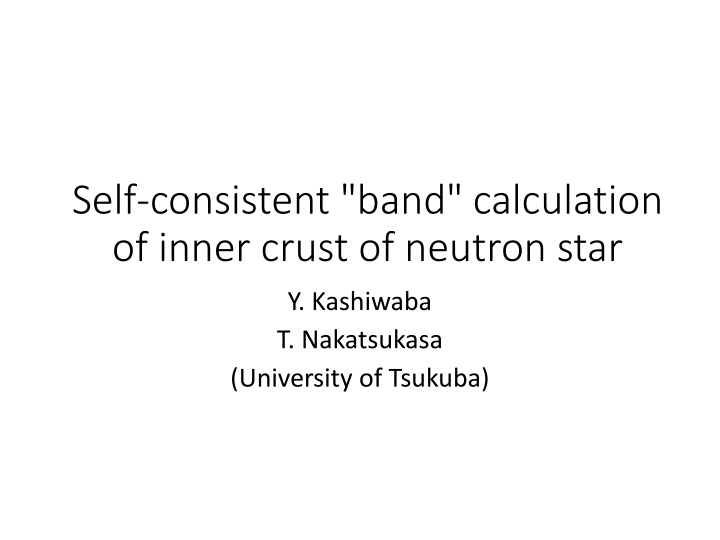
Microscopic Study of Neutron Star Inner Crust
Explore the detailed analysis of the inner crust of neutron stars, including complex nuclei structures, pasta phases, and their influence on crustal oscillations and cooling processes. Various quantum methods and boundary conditions are examined to understand the properties of pasta nuclei.
Download Presentation

Please find below an Image/Link to download the presentation.
The content on the website is provided AS IS for your information and personal use only. It may not be sold, licensed, or shared on other websites without obtaining consent from the author. If you encounter any issues during the download, it is possible that the publisher has removed the file from their server.
You are allowed to download the files provided on this website for personal or commercial use, subject to the condition that they are used lawfully. All files are the property of their respective owners.
The content on the website is provided AS IS for your information and personal use only. It may not be sold, licensed, or shared on other websites without obtaining consent from the author.
E N D
Presentation Transcript
Self-consistent "band" calculation of inner crust of neutron star Y. Kashiwaba T. Nakatsukasa (University of Tsukuba)
Neutron stars matter Outer crust Nuclei + electrons gas Neutron drip line Inner crust Neutron rich Nuclei + neutrons gas + electrons gas 0.001 0 0.5 0 Core Uniform nuclear matter + electrons 1.4~2 M 3~10 0 ( 0=3 1014g cm-3 ) William G. Newton (2013)
Bottom layer of inner crust Nuclei are expected to be complex structures. Outer crust Core mixed phase of gas and liquid 0.2~0.5 0 William G. Newton (2013)
Pasta phase in inner crust Black : liquid White : gas ~0.2 0 High density uniform K. Oyamatsu(1993) 0.5 0~ attractive nuclear interaction Coulomb repulsion
Pasta influence Crustal oscillation low frequency oscillation Cooling process low thermal conductivity Glitch phenomena (suddenly spin-up) angular momentum transfer from superfluid neutrons gas to normal component (nuclear lattice) B. Carter et al.: Int. J. Mod. Phys. D 15(2006) 777. H. Sotani et al.: Phys. Rev. Lett 108 (2012) 201101. C. J. Horowitz et al.: Phys. Rev. Lett. 114 (2015) 031102. Static and dynamical properties of the pasta nuclei are important
Previous works Semi-classical method Thomas-Fermi approximation Quantum Molecular Dynamics (QMD) calculation Quantum method Kohn-Sham(KS) method a. periodic boundary condition b. Wigner-Seitz approximation Bloch type boundary condition is required considering Bragg scattering of dripped neutrons.
Bloch type boundary condition ? ? + ? ???? + ? = ???? ????? ???? = ???? ?????, (? ? + ? = ? ? ) 2= ? ? 2 periodic density first Brillouin zone Bloch wave number kz( ? discretized into N points as ??= (?? ???? + ?? = ???(?) This allows us to reduce a large space to a unit cell. 0 < ? < ?? 0 < ? < ? By taking sufficient N, we can consider infinitely large lattice. ?< ??<? ?) is equally 1, ,?? (?))
Main Purpose Analyze pasta nuclei using the microscopic density functional approach Current Target : Slab nuclei Ground State (T = 0K) Parallel to each other Equally spaced by distance : a Uniform electron distribution distance : a [fm]
Bloch wave function The potential is periodic(z axis), constant (x, y directions). V(z + a)=V(z) KS equation : H(k) (k, z)=E (k, z) (k : 30 points) ? ?, ? = ??? ?? ??,? ,(? ? + ? = ? ? ) From Bloch theorem H (z)=E (z), (0<z<Na) H(k) (k, z)= (k, z), (0<z<a), independent every k
Self-consistent solutions Construct the proton and neutron density Calculate the potentials use Barcelona-Catania-Paris-Madrid (BCPM) energy functional (m*/m = 1, L=52.96 MeV, K0=212.4 MeV) Solve the Kohn-Sham (KS) equations z=0.2 fm , kz : 30 points
Energy functional Barcelona-Catania-Paris-Madrid(BCPM) density functional Volume term : local density approximations based on ab initio nuclear and neutron matter EOS (m*/m = 1, L=52.96 MeV, K0=212.4 MeV) 5 ????? + ?2? M. Baldo, L. M. Robledo, X. Vinas, Phys.Rev.C87,064305(2013) 5 1 ?2? ????? ????= ?? ?(?) ?=1 ?=1 Surface term : Gaussian folding fixing binding energy of finite 579 even-even nuclei ??? ???? ??? ?? (? )? ? ? 2/?0^2 ??? ?2/?02 ?? ??? ?? (? ) ????= ?,? =?,?
Results :Density distributions Results :Density distributions beta equilibrium ??= ??+ ?? ? ? + ? + ? ? = 0.06 fm-3 Neutrons Z/A = 2 ~4 % Dripped Neutrons 30.8 fm Protons ? = 0.07 fm-3 26.4 fm ? = 0.08 fm-3 20.4 fm High density
Results: Band structures of neutrons (k>0,ik=i-k) = 0.07 fm-3 fermi surface Band structures contain dynamical properties of pasta (?)[MeV] energy levels ??? unbound Effective mass m* ?2??? ??2 1 1 bound ? = 2 k= /a k=0 Bloch wave number k [fm-1] Effective mass (solid physics) is changed from bare neutron mass by Bragg scattering.
Bragg scattering Nuclear lattice Neutrons (k=n /a) are scattered by nuclear lattice free neutrons n n a [fm] ? =?? ?,(? = 0, 1, 2, )
Results: Mobility coefficient K How easily neutrons flow in nuclear lattice ??= ????? ? : current density ? : mobility coefficient ? : momentum Uniform 5% down Slab Mobility coefficient of neutrons for slab is about 5% smaller than uniform phase Neutrons gas becomes difficult to flow due to Bragg scattering of nuclear Pasta
Summary We have obtained the self-consistent solutions for the slab-like nuclei using Bloch type boundary conditions. Neutrons gas becomes difficult to flow due to Bragg scattering with nuclear lattice. This effect may cause some modifications to dynamical simulations such as glitch phenomena. Future works 2D (rod, tube), 3D (droplet, bubble) calculations
